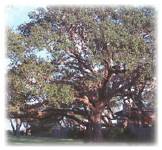Panhandle Plantings

Sudden Oak Death
Got your attention, didnít I? Piqued your curiosity? Hope so, because as a home gardener, your help is needed to prevent this disease from getting a foothold in Florida.
What is Sudden Oak Death? Itís a disease that was first noticed in the Netherlands and Germany, but more importantly was first identified in central coastal California in 1995. Since then it has been found in Oregon, Washington and western Canada. The pathogen that causes the disease is Phytophthora ramorum. In oaks, it can kill a tree in two to four weeks.
Letís make it perfectly clear from the outset that there is no Sudden Oak Death in Florida at this time. To quote Ed L. Barnard of the Florida Division of Forestry: "For sudden oak death to occur here, the pathogen (P. ramorum) must (1) successfully escape from its current spatial and possibly temporally limited distribution, (2) successfully establish itself in native environs, (3) successfully colonize our oaks in either natural or urban settings, and (4) succeed in killing our oaks. None of this has happened yet."
What has happened is that, as of June 2004, six nurseries in Florida have confirmed the presence of P. ramorum in their nursery stock. Some of this stock (Camellia japonica plants) originated at Monrovia Nurseries of Azusa, Calif. Additional stock (bonsai camellias) originated at Monrovia but was distributed through Specialty Plants, a California mail order nursery.
USDA-Plant Protection and Quarantine has allocated $20 million for fiscal year 2004 in an effort to contain the spread of P. remorum and discover a means of treating and/or eliminating the disease it causes. But even with all of that, the homeowner is the first line of defense in identifying the presence and/or spread of the P. ramorum pathogen. So whatís a body to do?
Homeowners are asked to concentrate their efforts on watching three specific types of plants: Camellias, Rhododendron and Viburnum. Look for two different syndromes: (1) leaf and twig blight and (2) bark canker. Leaves may exhibit undefined lesions on tips and edges, possibly progressing into the stem.Blighted tissue will turn tan to brown and may appear to have a reddish color. Plant defoliation may occur. P. ramorum cankers will secrete a red sticky sap. Stem blight will cause the stem tips to "wilt," resembling drought stress. "Wilting" will extend through the branch until the entire plant dies. Virburnum are especially susceptible. The roots of infected plants will always appear healthy.
If you know of a recently purchased camellia, rhododendron or virburnum that exhibit any of these symptoms, contact your local Extension Office. They will know the procedure for submitting samples to the appropriate agencies for testing. Where new plants have been introduced into an existing landscape, be aware that P. ramorum can be spread to established plants by movement of infected host material, infested soil, irrigation water and wind-blown rain. Log on to www.suddenoakdeath.org for further information and pictures of symptoms.
Last but not least, note that there is no fungicide or other treatment for this pathogen. Beware of pest control or landscaping companies that offer to treat your property for the prevention of Sudden Oak Death. If you should be approached, phone the Florida Department of Agriculture and Consumer Services Hotline at (888)397-1517.
Val Ford is a Holmes County Master Gardener. If you have a gardening question or problem, contact your local Extension Office or e-mail Val at FLSnowflake7592@aol.com
Page created and maintained by West Florida Electric Cooperative, Inc. © 2001.
designed by embryo design